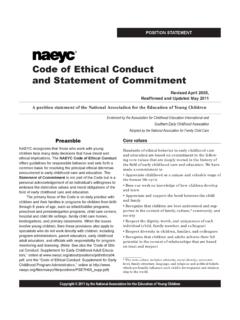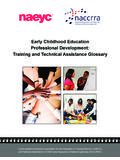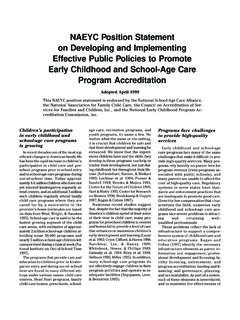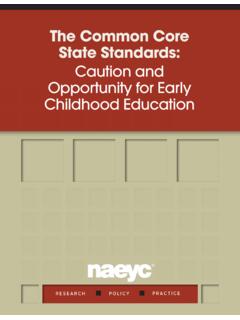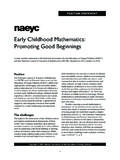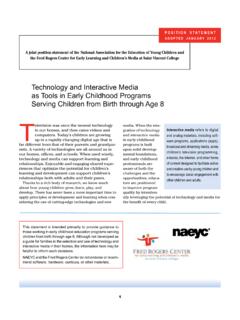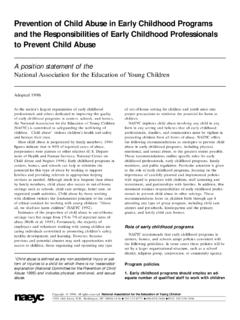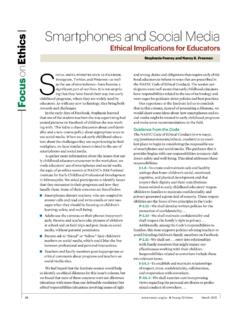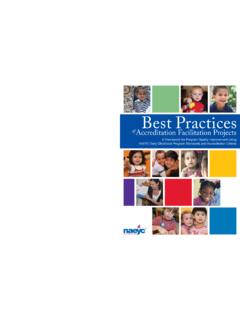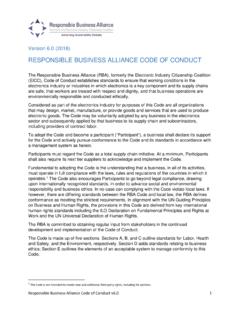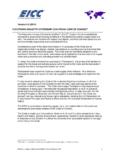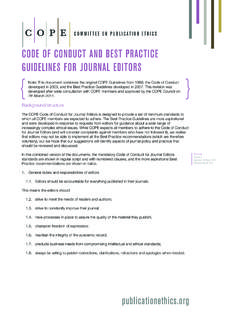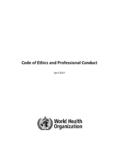Transcription of Code of Ethical Conduct and Statement of …
1 code of Ethical Conductand Statement of CommitmentA position Statement of the National Association for the Education of Young ChildrenPreambleNAEYC recognizes that those who work with young children face many daily decisions that have moral and Ethical implications. The NAEYC code of Ethical Conduct offers guidelines for responsible behavior and sets forth a common basis for resolving the principal Ethical dilemmas encountered in early childhood care and education. The Statement of Commitment is not part of the code but is a personal acknowledgement of an individual s willingness to embrace the distinctive values and moral obligations of the field of early childhood care and education. The primary focus of the code is on daily practice with children and their families in programs for children from birth through 8 years of age, such as infant/toddler programs, preschool and prekindergarten programs, child care centers, hospital and child life settings, family child care homes, kindergartens, and primary classrooms.
2 When the issues involve young children, then these provisions also apply to specialists who do not work directly with children, including program administrators, parent educators, early childhood adult educators, and officials with responsibility for program monitoring and licensing. (Note: See also the code of Ethi-cal Conduct : Supplement for Early Childhood Adult Educa-tors, online at and the code of Ethical Conduct : Supplement for Early Childhood Program Administrators, online at )Core values Standards of Ethical behavior in early childhood care and education are based on commitment to the follow-ing core values that are deeply rooted in the history of the field of early childhood care and education. We have made a commitment to Appreciate childhood as a unique and valuable stage of the human life cycle Base our work on knowledge of how children develop and learn Appreciate and support the bond between the child and family Recognize that children are best understood and sup-ported in the context of family, culture,* community, and society Respect the dignity, worth, and uniqueness of each individual (child, family member, and colleague)
3 Respect diversity in children, families, and colleagues Recognize that children and adults achieve their full potential in the context of relationships that are based on trust and respect* The term culture includes ethnicity, racial identity, economic level, family structure, language, and religious and political beliefs, which profoundly influence each child s development and relation-ship to the 2011 by the National Association for the Education of Young ChildrenPOSITION STATEMENTR evised April 2005,Reaffirmed and Updated May 2011 Endorsed by the Association for Childhood Education International and Southern Early Childhood Association Adopted by the National Association for Family Child Care2 NAEYC code of Ethical ConductRevised May 2011 Conceptual frameworkThe code sets forth a framework of professional respon-sibilities in four sections.
4 Each section addresses an area of professional relationships: (1) with children, (2) with families, (3) among colleagues, and (4) with the commu-nity and society. Each section includes an introduction to the primary responsibilities of the early childhood practitioner in that context. The introduction is followed by a set of ideals (I) that reflect exemplary professional practice and by a set of principles (P) describing prac-tices that are required, prohibited, or permitted. The ideals reflect the aspirations of practitioners. The principles guide Conduct and assist practitioners in resolving Ethical dilemmas.* Both ideals and principles are intended to direct practitioners to those questions which, when responsibly answered, can provide the basis for conscientious decision making. While the code provides specific direction for addressing some Ethical dilemmas, many others will require the practitioner to combine the guidance of the code with professional judgment.
5 The ideals and principles in this code present a shared framework of professional responsibility that affirms our commitment to the core values of our field. The code publicly acknowledges the responsibilities that we in the field have assumed, and in so doing sup-ports Ethical behavior in our work. Practitioners who face situations with Ethical dimensions are urged to seek guidance in the applicable parts of this code and in the spirit that informs the whole. Often the right answer the best Ethical course of action to take is not obvious. There may be no readily apparent, positive way to handle a situation. When one important value contradicts another, we face an Ethical dilemma. When we face a dilemma, it is our professional responsibility to consult the code and all relevant par-ties to find the most Ethical resolution. Section IEthical Responsibilities to ChildrenChildhood is a unique and valuable stage in the human life cycle.
6 Our paramount responsibility is to provide care and education in settings that are safe, healthy, nurturing, and responsive for each child. We are commit-ted to supporting children s development and learning; respecting individual differences; and helping children learn to live, play, and work cooperatively. We are also committed to promoting children s self-awareness, com-petence, self-worth, resiliency, and physical To be familiar with the knowledge base of early childhood care and education and to stay informed through continuing education and To base program practices upon current knowl-edge and research in the field of early childhood educa-tion, child development, and related disciplines, as well as on particular knowledge of each To recognize and respect the unique qualities, abilities, and potential of each To appreciate the vulnerability of children and their dependence on To create and maintain safe and healthy settings that foster children s social, emotional, cognitive, and physical development and that respect their dignity and their contributions.
7 To use assessment instruments and strategies that are appropriate for the children to be assessed, that are used only for the purposes for which they were designed, and that have the potential to benefit To use assessment information to understand and support children s development and learning, to support instruction, and to identify children who may need additional To support the right of each child to play and learn in an inclusive environment that meets the needs of children with and without disabilities. To advocate for and ensure that all children, including those with special needs, have access to the support services needed to be To ensure that each child s culture, language, ethnicity, and family structure are recognized and val-ued in the To provide all children with experiences in a language that they know, as well as support children in maintaining the use of their home language and in learning To work with families to provide a safe and smooth transition as children and families move from one program to the next.
8 * There is not necessarily a corresponding principle for each 2011 by the National Association for the Education of Young Children3 NAEYC code of Ethical ConductRevised May Above all, we shall not harm children. We shall not participate in practices that are emotionally dam-aging, physically harmful, disrespectful, degrading, dangerous, exploitative, or intimidating to children. This principle has precedence over all others in this We shall care for and educate children in positive emotional and social environments that are cognitively stimulating and that support each child s culture, lan-guage, ethnicity, and family We shall not participate in practices that discrimi-nate against children by denying benefits, giving special advantages, or excluding them from programs or activities on the basis of their sex, race, national origin, immigration status, preferred home language, religious beliefs, medical condition, disability, or the marital status/family structure, sexual orientation, or religious beliefs or other affiliations of their families.
9 (Aspects of this principle do not apply in programs that have a law-ful mandate to provide services to a particular popula-tion of children.) We shall use two-way communications to involve all those with relevant knowledge (including families and staff) in decisions concerning a child, as appropri-ate, ensuring confidentiality of sensitive information. (See also ) We shall use appropriate assessment systems, which include multiple sources of information, to provide information on children s learning and We shall strive to ensure that decisions such as those related to enrollment, retention, or assignment to special education services, will be based on mul-tiple sources of information and will never be based on a single assessment, such as a test score or a single We shall strive to build individual relationships with each child; make individualized adaptations in teaching strategies, learning environments, and cur-ricula; and consult with the family so that each child benefits from the program.
10 If after such efforts have been exhausted, the current placement does not meet a child s needs, or the child is seriously jeopardizing the ability of other children to benefit from the pro-gram, we shall collaborate with the child s family and appropriate specialists to determine the additional services needed and/or the placement option(s) most likely to ensure the child s success. (Aspects of this principle may not apply in programs that have a lawful mandate to provide services to a particular population of children.) We shall be familiar with the risk factors for and symptoms of child abuse and neglect, including physi-cal, sexual, verbal, and emotional abuse and physical, emotional, educational, and medical neglect. We shall know and follow state laws and community procedures that protect children against abuse and When we have reasonable cause to suspect child abuse or neglect, we shall report it to the appropri-ate community agency and follow up to ensure that appropriate action has been taken.
